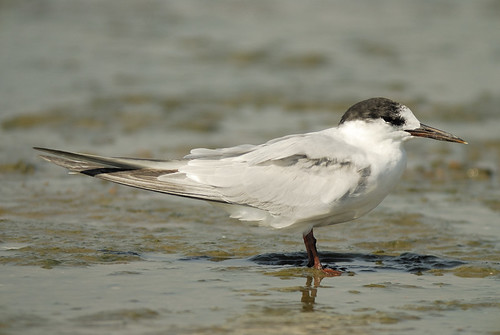tags: Common Tern, Sterna hirundo, birds, nature, Image of the Day
[Mystery bird] Common Tern, Sterna hirundo, photographed at the Texas City Dike, Texas. [I will identify this bird for you tomorrow]
Image: Joseph Kennedy, 19 September 2007 [larger view].
Nikon D200, Kowa 883 telescope TSN-PZ camera eyepiece 1/1500s f/8.0 at 1000.0mm iso400.
Rick Wright, Managing Director of WINGS Birding Tours Worldwide, writes:
This is the image that springs to mind when a birder hears the word "tern": a graceful rear end, the wingtips tapering into infinity above a long pointed tail; a slender, flat-backed body; an elegantly proportioned head with a neatly planed bill. As these past few quizzes have showed us, though, that classic description fits only a certain group among the sternines, namely, the white terns of the genus Sterna.
Like Calidris sandpipers, Sterna terns were ill-served by the archaic Petersonian method of field identification; the features that distinguish the species one from another are just too fine-grained to be of much use against a glary coastal sky. It's got much better in the last 25 years, with important work done by the Brits (chief among them the late Peter Grant), Scandinavians (Olsen and Larsson, among many others), and Americans (Kenn Kaufman's Advanced Birding remains essential for this group); an innovative and ultimately eye-opening approach is taken in Pete Dunne's Field Guide Companion.
The first thing the half-trained eye notices on the quiz bird is that the wing extends well beyond the tail. This feature is strictly useful only in the breeding season, but still it can serve as a first step away from the relatively long-tailed Forster's, Arctic, and Roseate Terns. The bird's body is not uniformly colored: both the dark primaries and the hint of a carpal bar (or is that just shadow? I really can't tell) contrast with the pale gray upperparts. The tarsus and bill are both medium-long: the former too long for the stumpy little Arctic Tern, the latter too short for the extravagantly billed Forster's and Roseate.
Could this be a Common Tern? Structurally it looks right, and the head shape -- with a rounded crown and a slightly angled forehead -- fits, too. The half-cap covering the crown and nape is also appropriate. Antarctic Tern (anything's possible) is said to be shorter-legged, paler-winged, and whiter-headed than Common Tern in equivalent plumages, leaving me satisfied that this is in fact a Common Tern.


Such a common bird...terned to the right.
Its a common tern in non-breeding plumage.
Common Tern
The extent of the black hood is key to separating Arctic and Common terns in non-breeding plumage.
This one has plenty of black, so its a Common tern.